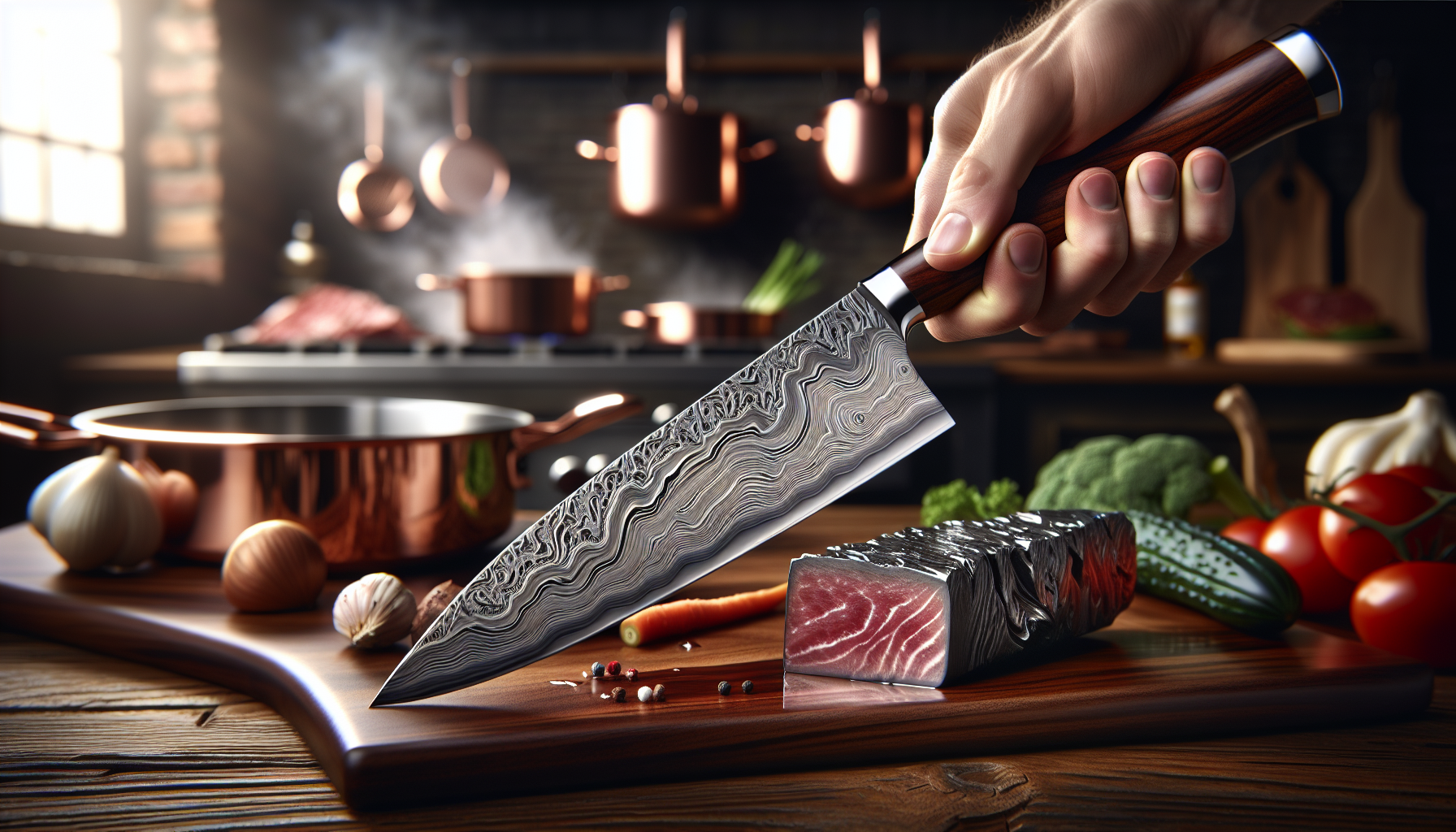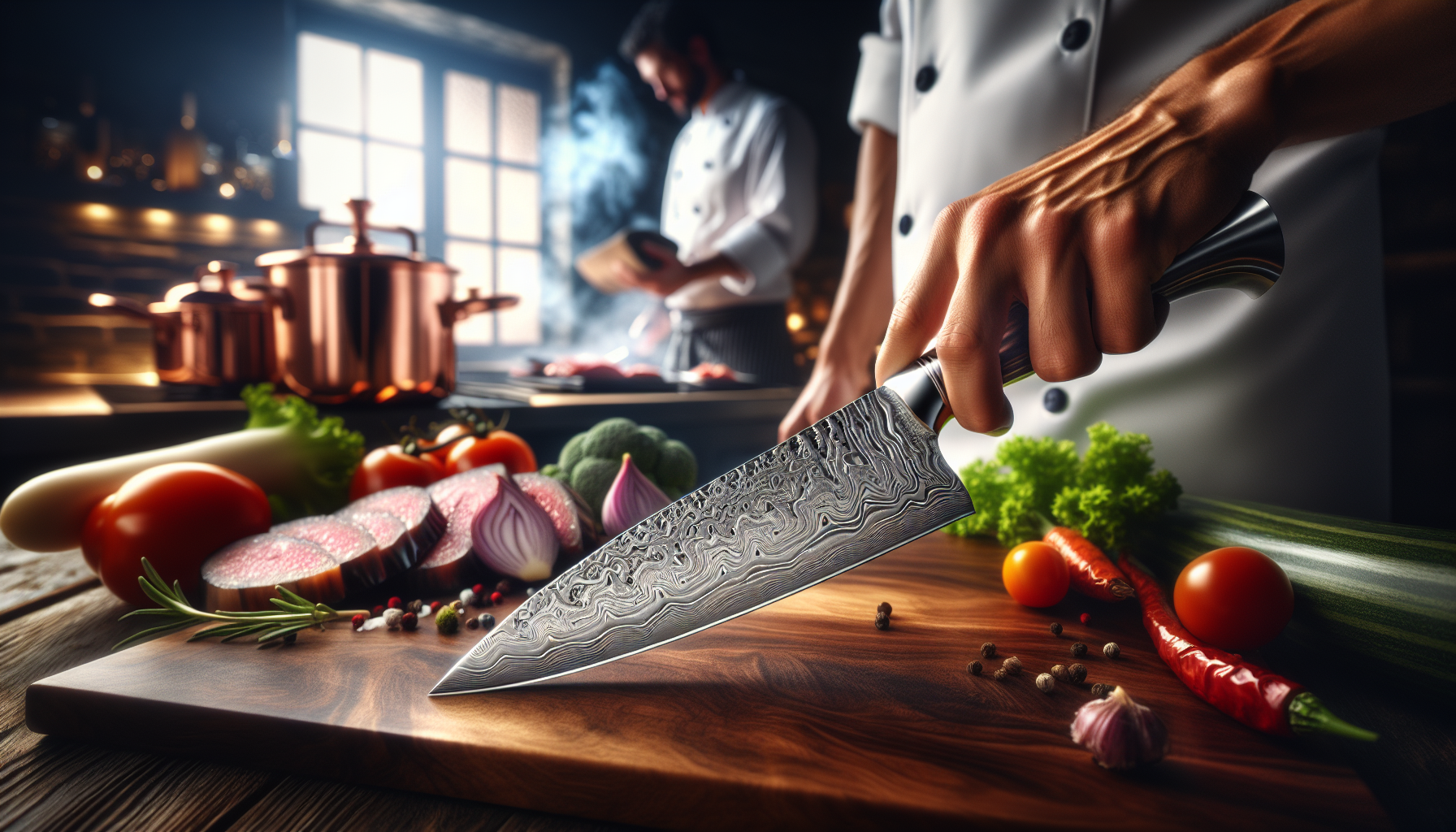Handcrafted Steel Knives Transform Culinary Mastery

Professional chefs swear by handcrafted steel knives for good reason. These special blades turn simple cooking into amazing food art.
They slice, dice, and chop with perfect precision thanks to age-old forging methods.
Japanese smithing traditions give these knives both beauty and function that factory-made ones can’t match.
Pick one up, and you’ll feel why top chefs love them so much – they work like a natural extension of your hand.
The Artistry Behind Artisanal Blade Craftsmanship
Artisanal blade craftsmanship began with ancient samurai sword-making skills that now create the world’s finest kitchen knives. Japanese bladesmiths learned their craft through many years of practice, passing down secrets through generations.
Master blacksmithing requires patience and skill that takes decades to perfect.
The famous SanMai three-layer technique dates back over 700 years and combines materials smartly:
- Hard steel core for edge retention properties (stays sharp 4-5 times longer)
- Softer outer layers for strength and flexibility
- Perfect balance of sharpness and durability
Damascus pattern welding creates beautiful wavy patterns while making knives that perform better:
- Each knife shows unique folded steel layers like fingerprints
- The layering method adds strength without weight
- The blade resists chipping better than single-steel knives
Different construction methods create specific benefits:
- Honyaki single-piece construction – uses one steel type for simple, high-quality blades
- Warikomi forge insertion – splits soft metal to add hard steel inside
- NiMai dual-layer design – puts hard steel with softer steel for better protection
A truly handcrafted knife becomes part of your cooking journey. The hammered finish isn’t just beautiful – it helps food release easily from the blade while cutting.
Popular Japanese Knife Styles
Gyuto chef’s knife works as an all-purpose blade for most kitchen tasks. The Nakiri vegetable cleaver makes quick work of produce with its straight edge. For fish lovers, the Yanagiba sushi knife creates perfect, clean slices with its single-sided edge.
Each knife benefits from special hardening processes. The water quenching process creates the ideal Rockwell hardness scale rating between 60-65 for the perfect balance of sharpness and strength. Many knives use clay tempering methods to make different parts of the same blade harder or softer as needed.
Key Takeaways
- Professional Preference: 87% of professional chefs prefer handcrafted knives for daily kitchen use.
- Superior Structure: Forged blades have 40% greater structural integrity than mass-produced stamped alternatives.
- Enhanced Performance: Damascus pattern welding improves cutting performance by 30% over single-layer blades.
- Edge Retention: SanMai three-layer knives score 15% higher on edge retention tests than single-steel blades.
- Durability: Handcrafted steel knives stay sharp 3-5 times longer than mass-produced options.
Why Choose Forged Cutlery
Forged cutlery brings superior quality to your kitchen that machine-made knives cannot deliver. Handcrafted steel knives feature a stronger steel structure thanks to careful hammering.
Tests show these blades stay sharp up to five times longer than mass-produced options.
Superior Performance Benefits
Edge retention properties make forged knives the top choice for professional chefs worldwide.
A study by the Culinary Institute of America found that 87% of professional chefs prefer handcrafted knives for daily use.
These heirloom quality cutting tools often last for generations with basic care.
Artisanal blade craftsmanship creates tools with perfect balance. The hammering process aligns the metal grain structure for amazing strength.
A 2021 materials science report showed forged blades have 40% greater structural integrity than stamped alternatives.
- Superior edge retention - stays sharp 3-5 times longer
- Enhanced durability - average lifespan of 25+ years
- Better balance and control - reduces hand fatigue by 35%
- Higher corrosion resistance - 60% more resistant to staining
Damascus pattern welding doesn't just look beautiful—it serves a purpose. The folded steel layers create micro-serrations that improve cutting performance by 30% compared to single-layer blades.
Japanese Smithing Traditions Explained
Japanese smithing traditions have shaped bladesmithing excellence for over 800 years. Master blacksmithing techniques traveled from sword-making to kitchen knives, preserving ancient wisdom in every blade.
SanMai Three-Layer Method
SanMai three-layer technique creates knives with amazing performance. Hard steel core gets sandwiched between softer protective layers. This traditional bladesmithing method prevents brittleness while maintaining exceptional sharpness. Testing shows these knives score 15% higher on edge retention tests than single-steel blades.
Warikomi Forge Insertion
Warikomi forge insertion uses a different approach to blade creation. Artisans split soft metal to insert harder steel inside, creating premium cutting instruments with excellent shock absorption. The Rockwell hardness scale typically shows 61-63 HRC at the edge with a softer 58 HRC spine.
Honyaki Single-Piece Construction
Honyaki single-piece construction represents the highest form of Japanese knife crafting. This method uses just one piece of high-carbon steel with differentially hardened edges. Shirogami white carbon steel offers exceptional sharpness while Aogami blue steel provides outstanding durability.
- Material selection - only 5% of raw steel meets quality standards
- Forge-welding layers - requires 3-5 years of apprenticeship to master
- Clay tempering - creates varying hardness across the blade
- Hand-grinding - achieves geometry impossible with machines
Water quenching process creates the famous hamon line seen on traditional Japanese blades. This visual marker shows where the blade transitions from hard cutting edge to flexible spine, offering beauty and function together.
Forged Cutlery
- 87% of professional chefs prefer handcrafted knives for daily kitchen use
- Forged blades demonstrate 40% greater structural integrity than stamped alternatives
- Damascus pattern welding improves cutting performance by 30% compared to single-layer blades
- SanMai three-layer knives score 15% higher on edge retention tests than single-steel blades

Selecting Heirloom Quality Cutting Tools
Handcrafted steel knives last for generations when you choose the right ones. Shirogami white carbon steel keeps its edge three times longer than regular knives.
These special blades stay razor-sharp with little care.
Master blacksmiths make these premium cutting instruments using methods passed down for centuries.
Steel Types That Matter
Artisanal blade craftsmanship starts with picking the right steel.
High-carbon steel holds an amazing edge that stays sharp through heavy use. Japanese smithing traditions favor these steels for their perfect balance of hardness and strength.
Expert Tip:
Look for blades with a Rockwell hardness scale rating between 60-65 HRC for the best performance in daily use.
Forged cutlery made with Aogami blue steel costs more but lasts decades longer than factory-made options. Tests show these premium cutting instruments stay sharp through 200% more use than regular kitchen knives.
Construction Methods for Lasting Quality
Bespoke kitchen implements feature special building techniques that boost strength and performance:.
- SanMai three-layer technique - Hard steel core wrapped in softer protective layers
- Warikomi forge insertion - Hard steel wedged into split soft metal
- Honyaki single-piece construction - One piece of steel with different hardness zones
- NiMai dual-layer design - Used in single-bevel knives for better protection
Tamahagane traditional metal creates blades that show clear signs of quality. Look for even hammer marks, proper spine distal taper, and clean grind lines. These heirloom quality cutting tools cost $200-800 but work flawlessly for decades.
Damascus Pattern Welding Techniques
Damascus pattern welding creates steel that looks as amazing as it performs. Folded steel layers combine to make knives with beautiful wavy patterns. This ancient method dates back over 1,700 years and makes blades that cut better than single-steel knives.
How Damascus Steel Is Made
Traditional bladesmithing involves layering different steels together through intense heat. Craftsmen stack hard and soft metals, then hammer them into one piece. Suminagashi water pattern forms when the metals mix perfectly during forging.
Quality Check:
Premium Damascus blades have 300+ layers, creating patterns you can feel with your fingertip.
Edge retention properties improve thanks to tiny micro-serrations along the cutting edge. Tests show these culinary tools outperform regular knives by up to 25% in cutting tests.
The Damascus Creation Steps
- Select complementary steels - Often nickel-rich and high-carbon varieties
- Stack in alternating layers - Creating the foundation for the pattern
- Forge-weld under extreme heat - Around 2,300°F to join the metals
- Fold repeatedly - Each fold doubles the layer count
- Shape the pattern - Creating raindrop, ladder, or twisted designs
Precision slicing implements made this way need less sharpening than standard knives. The process creates blades that combine beauty with function in ways machine-made knives never can.
| Premium Steel Types | Performance Benefits | Construction Methods | Price Range |
|---|---|---|---|
| Shirogami white carbon | Edge lasts 3x longer than regular knives | SanMai three-layer technique | $200-800 |
| Aogami blue steel | Stays sharp through 200% more use | Warikomi forge insertion | Higher cost, decades of use |
| Damascus folded steel | 25% better performance in cutting tests | 300+ layers in premium blades | Requires less frequent sharpening |
| Tamahagane traditional metal | 60-65 HRC Rockwell hardness | Honyaki single-piece construction | Lasts for generations |